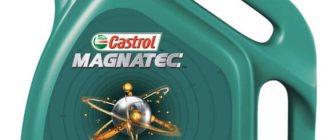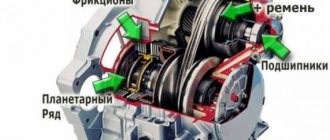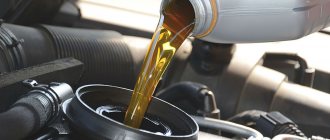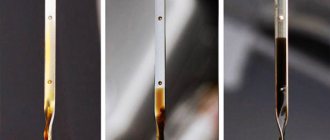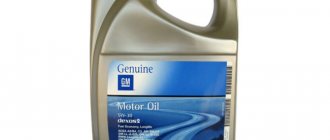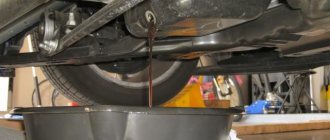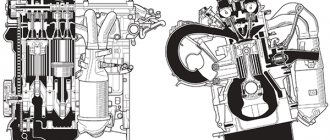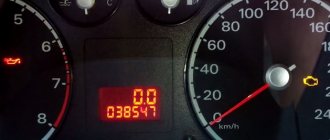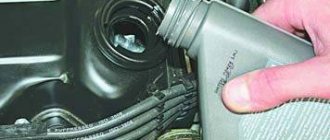Over its 17 years on the market, the Mazda 3 has undergone changes over four generations. The compact car of the Japanese manufacturer in 2003 successfully replaced its predecessor, sending the Mazda Familia to the outskirts of auto industry history.
With the change of generations of the model, its engine was also modified, the volumes and tolerances for the type of oil changed. Questions arise: When and how often does it need to change the engine oil? What volume will be required for a specific engine, generation of car? What is the difference in using original and non-original oils? What problems can you encounter and how to avoid them. Let's try to build a system.
When to change oil in Mazda 3
The manufacturer recommends changing the oil once a year or during vehicle maintenance at 5, 15, 30, 45, 60, 75, 90, 105, 120, 135 thousand km, every 10-15 thousand km. The oil filter must be replaced along with it. In the case when the car has covered less than 15 thousand km, but the year has expired, it is necessary to update the oil due to a change in its properties. The liquid ages and loses the necessary qualities, which can negatively affect the engine’s service life. A delay of 3 months or several thousand kilometers is considered not critical.
It is necessary to take into account the individual characteristics of the vehicle operation and its exposure to difficult conditions, long periods of downtime, and engine wear. And if the oil level is zero, you definitely shouldn’t rely on any recommendations or calculations, you need to act!
Fault overview and repair
This engine has a special window on the front cover through which the user can carry out maintenance of the elements. From here you can, for example, unlock the ratchet, adjust the timing chain or lock the tension arm. In general, the engine is one of the best in terms of maintainability among analogues. This is evidenced not only by the reduction in the number of auxiliary belts, but also by other features. Many components and systems are controlled and monitored by sensors and electronics:
- The valve timing actuator constantly monitors the state of the exhaust and intake valve phases, controlling them using OCV hydraulic pressure;
- The oil valve is controlled by the PCM electrical unit;
- The crankshaft speed is regulated by a sensor that sends a signal to the computer;
- The operation of the camshafts is also controlled by the control unit through a separate sensor;
- The engine is lubricated using an oil pump mounted on the end of the sump. The entire feed is controlled electronically and requires no maintenance.
How much oil is in a Mazda 3 car engine
First generation (1st generation) BK
The first generation (2003-2009) Mazda 3 was presented in two body types - hatchback and sedan; it was strikingly different from its predecessor in its modern sporty design, increased dimensions, and a more powerful engine. The maximum speed of the car has increased and fuel consumption has decreased by more than 10%. The appearance was reminiscent of the first generation Mazda 6 and indicated a modification of the entire family from Mazda Motor Corporation. In 2006, restyled updates to the model included improved sound insulation, interior improvements, and modified bumpers. Basic equipment has expanded to include ABS DSC (EBD) systems. At the same time, sports versions MPS and Flash Edition appeared.
Also read: Automatic transmission oil Mazda CX-5
First generation engines (2003 - 2008)
Gasoline engines:
- 1.6 MZR Z6 (105 hp) - oil volume 3.9; approvals API SL/SM/SN, ACEA A3/A5
- 2.0 MZR LF17 (150 hp) - oil volume 4.3; approvals API SL/SM/SN, ACEA A3/A5
- 2.3 MZR L3-V (156 hp) - oil volume 4.3; approvals API SL/SM/SN, ACEA A3/A5
- 2.3 MZR L3-VE (171 hp) - oil volume 4.3; approvals API SL/SM/SN, ACEA A3/A5
Diesel engines:
1.6 MZR Y601 (109 hp) - oil volume 3.9; approvals API CF, ACEA B3 2.0 MZR RF7J (143 hp) - oil volume 4.3; API CF, ACEA B3 approvals
Second generation BL
The second generation (2009-2013) again modified the design and interior of the model. Mazda 3 continued to increase in size, this time the developers managed to reduce the overall weight of the structure. Drastic changes to the interior added a progressive navigation system, leather upholstery with heated seats and memory, dual-zone climate control, improved sound insulation and a Bose stereo system. Reistaling 2011 modified the exterior. The bumpers, fog lights, and radiator grille have been transformed. The trend of increasing and decreasing vehicle weight continued. The ESS system appears in the security complex; during emergency braking, it automatically turns on the light alarm, drawing the attention of road users driving behind.
Second generation engines (2009 - 2013):
Gasoline engines:
- 1.6 MZR Z6 (105 hp) - oil volume 4.3; approvals API SL/SM/SN, ACEA A3/A5
- 2.0 MZR LF17 (150 hp) - oil volume 4.3; approvals API SL/SM/SN, ACEA A3/A5
- 2.0 MZR LF5H (150 hp) - oil volume 4.3; approvals API SL/SM/SN, ACEA A3/A5
- 2.5 MZR L5-VE (170 hp) - oil volume 4.3; approvals API SL/SM/SN, ACEA A3/A5
Diesel engines:
1.6 MZR Y601 (109 hp) - oil volume 3.9; approvals API CF, ACEA B3 2.2 MZR R2FF (150-185 hp) - oil volume 4.3; API CF, ACEA B3 approvals
Third generation BM
The third generation (2013-2019) was marked by the appearance of a new SkyActiv engine. It was possible to improve the car's handling, increase speed characteristics, reduce fuel consumption, and reduce the amount of harmful substances in exhaust gases. In addition to the new engine, the gearbox was improved, which became six-speed. The new design of the car in the KODO style (associations with the image of a predator due to the relief lines directed along the body and elongated front and rear headlights, radiator grille) became recognizable in the car traffic, modern optics with LED daytime running lights corresponded to fashion trends.
Also read: Engine oil for Mazda Tribute engine
Third generation engines (2013 - 2021):
Gasoline engines:
- SkyActiv–G 1.5 P5 VPS (100-120hp) — oil volume 3.9; approvals API SL/SM/SN, ACEA A3/A5
- SkyActiv–G 2.0 PE VPS (150-165 hp) — oil volume 4.2; approvals API SL/SM/SN, ACEA A3/A5
- SkyActiv–G 2.5 PY VPS (185-195 hp) — oil volume 4.2; approvals API SL/SM/SN, ACEA A3/A5
Diesel engines:
- SkyActiv–D 1.5 S5 DPTS (105 hp) — oil volume 5.1; API CF, ACEA B3 approvals
- SkyActiv –D 1.8 S8 DPTS (115 hp) - oil volume 5.1; API CF, ACEA B3 approvals
- SkyActiv –D 2.2 SH VPTS (175-190 hp) - oil volume 5.8; API CF, ACEA B3 approvals
Fourth generation BP
The fourth generation (2021 – present) Mazda 3 continues to represent the beloved hatchback and sedan. In the exterior of the latter, the aggressive side reliefs are smoothed out, acquiring smoothness and elegance, and the characteristic hood becomes even longer. The hatchback retains its sporty styling and iconic short trunk. The interior of the two body types is the same. The car is packed with all-round visibility systems, blind spot monitoring (BSM), traffic sign recognition (TSR), lighting with automatic light control (ALH) and other electronic assistants. Also introduced is the new Skyactiv-X engine - a petrol engine with a diesel operating principle for maximum efficiency, the performance of which can only be appreciated by time.
Fourth generation engines (2019 - present):
Gasoline engines:
- SkyActiv–G 1.5 P5 VPS (100-120hp) — oil volume 3.9; approvals API SL/SM/SN, ACEA A3/A5
- SkyActiv– G 2.0 P5 VPS (100-120 hp) — oil volume 3.9; approvals API SL/SM/SN, ACEA A3/A5
- SkyActiv-X 2.0 PE VPS (181 hp) - oil volume 4.2; approvals API SL/SM/SN, ACEA A3/A5
- SkyActiv–G 2.5 PY VPS (185-195 hp) — oil volume 4.2; approvals API SL/SM/SN, ACEA A3/A5
Diesel engines:
- SkyActiv –D 1.8 S8 DPTS (115 hp) - oil volume 5.1; API CF, ACEA B3 approvals
L3 tuning options
The main stages of engine tuning are related to the improvement of interconnected components and systems:
- Upgrading your car's exhaust system will have a positive effect on traction. The systems CorkSport, AutoExe, Greddy and others are very popular among Mazda drivers. Often a branded cutback is installed, without removing the catalysts;
- On most modifications of L3 engines, it is enough to change the ignition timing by a few degrees to add power;
- Chip tuning is another well-known method of increasing the power characteristics of an internal combustion engine. During this modernization, the control unit, which was initially configured with restrictions for operating conditions, legal aspects and environmental standards, is reflashed. However, chipping is only useful for turbocharged versions of the L3; for naturally aspirated engines, this procedure will be useless;
- Jetter installation. This is a compact electronic unit that allows you to change the speed of throttle response after pressing the accelerator pedal.
The above tuning methods allow you to increase engine power several times. Depending on the specific technology, engine power can increase to 350 hp. With.
What kind of oil to pour into the engine
Original
The Mazda Original Oil Ultra 5W30 canister contains the following technical specifications:
- API SL/CF, where API is a motor oil classification system developed by the American Petroleum Institute, in other words, the same tolerance. SL - the first letter (S) indicates that it belongs to gasoline engines, (L) means optimal quality for vehicles manufactured since 2001. The next fraction sign (/) indicates the variation of engine types indicated by the manufacturer - gasoline plus diesel. The latter is designated by the letter (C). The letter (F) indicates the possibility of use in SUVs manufactured since 1994. SAE5W-30, where SAE (Society of Automotive Engineers) is a US society of automotive engineers who developed a classification of motor oils by viscosity. The first number (5) indicates the degree of viscosity at low temperatures. (W) means winter. 5W indicates the low-temperature viscosity of the substance (this indicator must be subtracted from the number 35) and allows the car to be started at -30 °C. The third part of the marking (30) sets the upper temperature threshold (it is calculated by subtracting the first number from the last), it is equal to 25°C. Thus, the designations indicate that the oil is all-season and retains its performance from -30 to 25 °C.
- ACEA A5/B5, (ACEA) European Automobile Manufacturers Association - association of European automobile manufacturers. The designation (A/B) indicates recommendations for gasoline and light diesel engines. Divided into three classes A3/B3, A3/B4, A5/B5. (A5/B5) - indicates all-season performance of low-viscosity motor oil intended for use in passenger gasoline and diesel engines.
Also read: Engine oil for MAZDA 6 engine
If the owner of a Mazda 3 prefers an ordinary service station to an official dealer, or decides to cope with a technical task on his own, then the oil recommended by the manufacturer can be safely replaced with analogues. You just have to comply with the listed technical characteristics and choose a worthy manufacturer.
How to distinguish original oil
Analogs
- Liqui Moly AA 5W30 is a German synthetic oil with equally good characteristics, aimed at various American and Japanese-made engines.
- Total Future NFC 9000 5W30 is a French product from the same Total company that produces the officially recommended oil for Mazda.
- Mobil Super 3000 X1 Formula FE 5W30 is also a high-quality American motor oil that is widely available on store shelves.
List of L3 modifications
Here are the modifications of this internal combustion engine:
The turbocharged modification L3-VDT is structurally no different from the basic version, except for the presence of a turbocharger. Direct fuel injection. The engine has an additional air cooler - intercooler. Ignition is carried out using a coil on a spark plug. This power unit develops power up to 263 hp. With. at 6700 rpm. Only he does not recognize low-grade and low-octane fuel. It is recommended to pour only AI-98.
Oil selection table by season (winter, summer)
| Year | Viscosity SAE all season from +25 to -25 °C | winter from -35 to +5 °C | summer from -5 to +45 °C |
Gasoline API Diesel API Type Recommended manufacturers
200310W-30 10W-40 15W-40 15W-30
| 5W-20 5W-30 5W-40 | 20W-40 20W-30 25W-30 25W-40 |
SJCG semi-synthetics, mineral water ZIC, Lukoil, Valvoline, Select, Kixx, G-Energy, Rosneft, Mannol, Lotos200410W-30 10W-40 15W-40 15W-30
| 5W-20 5W-30 5W-40 | 20W-40 20W-30 25W-30 25W-40 |
SJCG-4semi-synthetic, mineral waterMobil, Rosneft, Select, Mannol, Lotos200510W-30 10W-40 15W-40 15W-30
| 5W-30 5W-40 0W-30 | 20W-40 20W-30 25W-30 25W-40 |
SJCHsemi-synthetic, mineral waterMobil, Select, Mannol, Lotos200610W-40 5W-40
| 5W-40 | 20W-40 25W-30 25W-40 |
SHCH-4semi-synthetic, mineral waterMobil, ZIC, Lukoil, Valvoline, Rosneft, Select200715W-40 10W-40 5W-40
| 0W-30 5W-40 5W-30 | 20W-30 20W-40 25W-30 |
SJCH-4semi-synthetic, mineral waterMobil, Lukoil, Valvoline, Rosneft, CONSOL200810W-40 5W-40
| 0W-30 5W-40 | 20W-40 25W-30 25W-40 |
SLCH-4semi-syntheticsMobil, ZIC, Lukoil, Valvoline, Rosneft, CONSOL
Main characteristics
Any automotive fluid is characterized by several main parameters, which must be consistent with the type and needs of the engine. Knowing these parameters, you can choose oil even from completely unfamiliar brands. For Mazda 3, the division into fluids for gasoline and diesel engines is primarily relevant, since the model was produced in both configurations.
Filling all engines with oil intended for gasoline means significantly reducing the service life of the mechanism and the car as a whole. Universal adaptive fluid is also not recommended for the third model. This oil is positioned as a gasoline-diesel oil, but in practice it is inferior to specialized lubricant.
The second important parameter is the level of quality. It is measured using a special international API scale. Engines from the Japanese manufacturer are reliable, but sensitive to the quality of the liquids entering them, so you need to select oil not lower than a certain level. For a gasoline engine, the minimum quality will be SL, better SM and SN. For stable operation, a diesel engine will require B3, B4 or CE and CF; the best choice would be CF-4 class oil.
The third selection criterion is compliance with operating conditions and viscosity index. Obviously, the same oil will not be suitable for car enthusiasts in hot climates and Mazda owners in regions with harsh winters, so advice on various forums should be taken carefully. If the ambient temperature often drops below minus ten, preference should be given to oil with a viscosity of at least 5W20. For a car that does not experience “hypercooling,” a fluid with a value of about 10W40 is suitable.
Top 5. Castrol Magnatec 5W-30 A5 DUALOCK
200 reviews from resources were taken into account: Yandex.Market, Ozone, Otzovik
- Characteristics
- Price per liter: 525 rub.
- Container (l): 4; 5; 10
- API classification: SN, CF
- ACEA classification: C3, A1/B1, A5/B5
- Additional classification: no
- Pour point: -39°C
Country: England
If your Mazda 3 is primarily used in urban environments, then you know how much more often the oil needs to be changed compared to those who travel on the highways. Constant stops, changes in speed and sudden braking - all this negatively affects the engine, and the best way to protect it is to fill it with Magnatek oil. It uses a special magnetization technology. The composition does not contain molybdenum or titanium, but the film adheres very tightly to the parts, maintaining their performance. Note that the technology is not unique and is often used by other manufacturers. But it is at Magnatek that the main emphasis is placed on it. The product is suitable for owners of small 1.6 or 1.8 liter engines.
Advantages and disadvantages
- Special magnetization technology
- Affordable price
- Lots of phosphorus in the composition
- No molybdenum or titanium
Manufacturer's recommendations
The Japanese concern, discarding unnecessary modesty, recommends using exclusively the original liquid of its own design. Mazda engine oil is produced under the Total brand. Previously, it was known to car owners under the name DexeliaUltra 5W30. However, recently, during another rebranding, the name was changed to the more euphonious OriginalOilUltra, but the oil inside the canister is still the same.
And, although the manuals do not indicate that no other lubricant can be used, official dealers are guided by this very principle. While the car is under warranty, you will have to be content with only the expensive original. Reviews from owners of the third model about this oil are mixed. The engine runs stably, produces good power, and fluid consumption is low. But many analogues show properties no worse, and sometimes much better, while finding them on sale is easier, and the price is more affordable.
Analogues of original oils
When deciding what oil to fill in a Mazda VK, you don’t have to exhaust yourself with searching for a unique original. Moreover, many major brands produce formulations with the same characteristics.
Approved analogues by tolerance
4 liters Article: 156ED5
Cost: 2,200
4 liters Article: 4008177079948
Cost: 2,050 rub.
4 liters Article: 1539424
Cost: 1,990 rub.
4 liters Article: 1538770
Cost: 1,870 rub.
List of car models
Here are the cars the L3 series engines were installed on:
- The base L3 engine was installed on the following cars: Mazda MPV LW minivan 2nd generation and Mazda Tribute EP 1st generation;
- Modification L3-VDT - for hatchback Mazda Axela BK/BL 1st and 2nd generations of 2006-2011 years of production and CX-7 ER 1st generation of 2006-2012 years of production. Also, a turbocharged engine was installed on the 1st generation Mazda Atenza GG sedan, 1st generation Mazda 3 BK hatchback and 3rd generation Mazda MPV LY minivan;
- L3-VE was installed on Mazda Atenza GG hatchbacks and station wagons of the 1st generation 2002-2007, Mazda Axela BK sedans and hatchbacks 2003-2006, Mazda Biante CC minivan 1st generation, Mazda 3 BK sedans and hatchbacks 1st generation, Mazda MPV LY minivan 3 generations, Mazda Premacy CR minivan 2 generations and Mazda Tribute EP 1 generation;
- L3KG was installed on the hatchback Mazda 3 MPS BL 2nd generation and Mazda 6 MPS GG 1st generation;
- L3C1 is installed on sedans, station wagons and hatchbacks Mazda 6 GG 1st generation 2002-2008;
- L3-DE - for the 2nd generation Mazda MPV LW minivan produced in 2002-2006.


